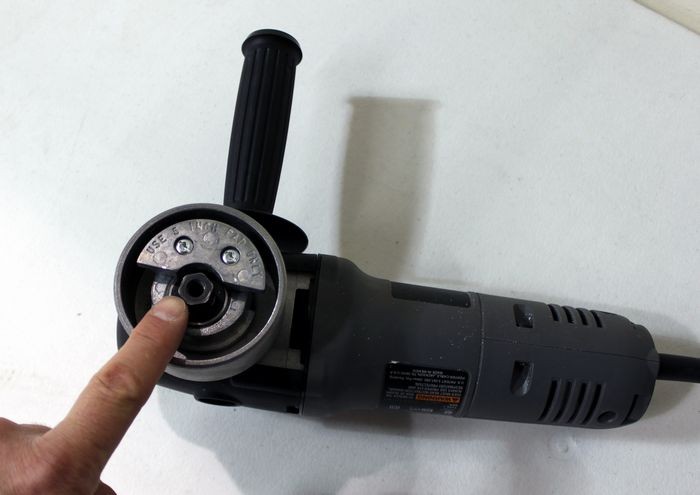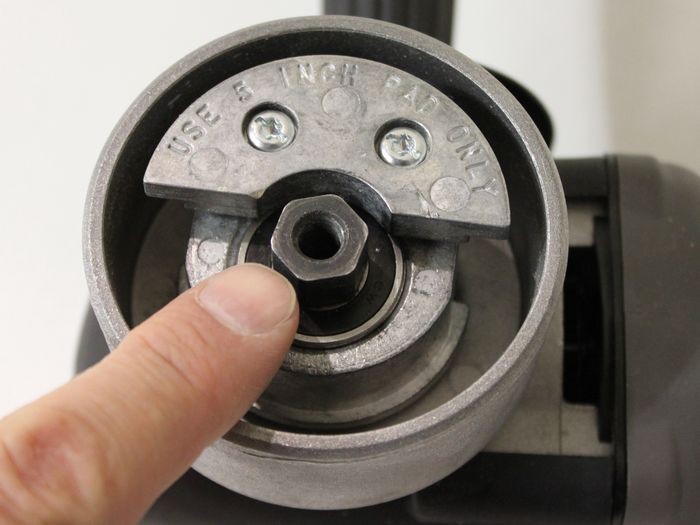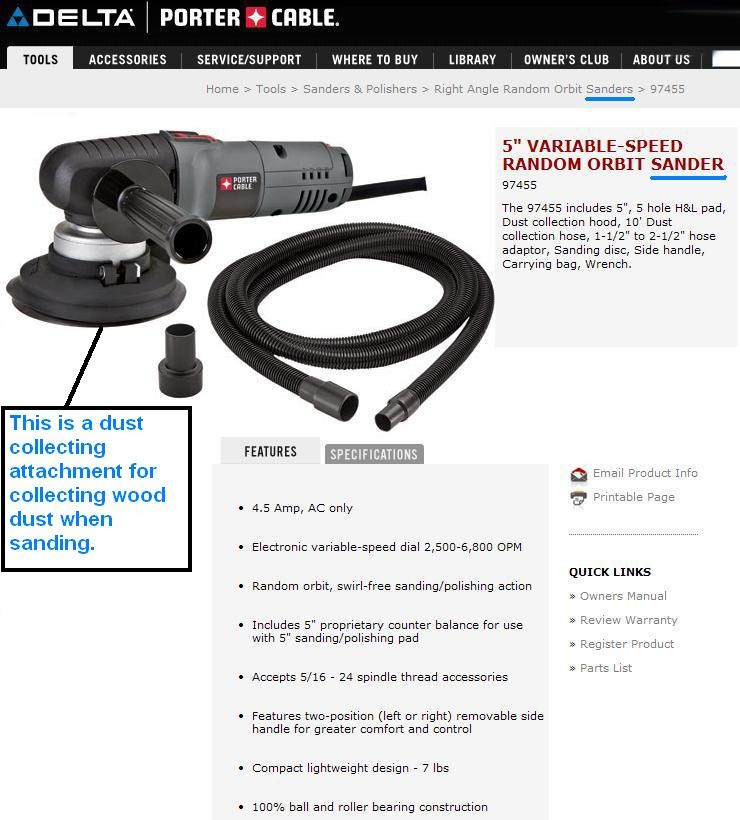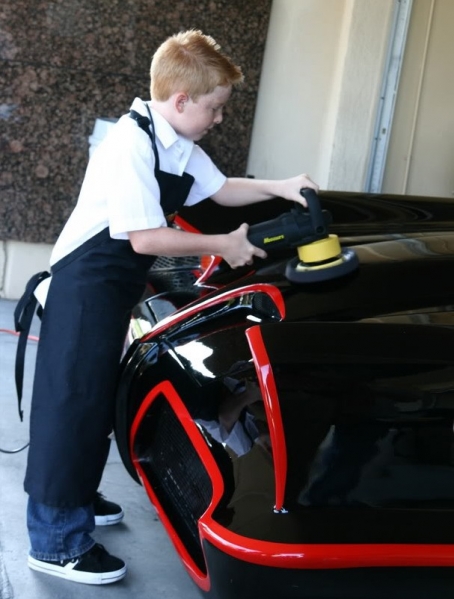The Free Floating Spindle Assembly - The Story Behind The Story... by Mike Phillips
Below is a reply from Porter Cable taken from another thread on another forum... links have been removed for professional netiquette...
Thank you to MisterShark for taking the initiative to contact Porter Cable and get their definition, explanation and description of how the mechanism works that makes the Porter Cable DA Polishers both safe, effective and unique.
Note the Meguiar's versions and the Griot's Garage Versions of the Porter Cable Polisher use a similar design, that is these two other polishers also use a Free Floating Spindle Assembly.
In the below pictures, I'm pointing to what's referred to as the Free Rotating Spindle Assemble of a Porter Cable Dual Action Polisher.
Porter Cable 7424XP with the Backing Plate Removed Exposing the
Counterweight and Free Rotating Spindle Assembly

Close-up

From Hand to Machine
In the last 15 to 20 years a lot of people have made the switch from working by hand to working by machine because it's faster and more effective, especially on modern day clear coat paints.
Clear Coat Paints Are Scratch-Sensitive
Modern clear coat paints last longer than traditional single stage paints like the lacquers and enamels that were used to paint cars from the time the Model T was introduced till the early 1980's. In the early 1980's car manufactures began switching over to a new paint system called Basecoat/Clearcoat where the color coat or pigmented layer of paint is sprayed onto the car first and then a layer of clear paint is sprayed over the top of the color coat. Besides being a different approach, the resin used to make the paint changed also.
Longer Lasting
The results are paints that resist oxidation, (oxidation was a huge problem with single stage paints), and last much longer over the service life of the vehicle as compared to single stage paints.
Scratch-Sensitive = Easily Scratched = Eyesore
The problem is people confuse last longer with look good longer and these are two very different things. A modern clear coat finish can last a long time but that doesn't mean it will look good over this period of time. You see clear coat paints are scratch-sensitive, that means even though they tend to be harder than traditional single stage lacquers and enamels, they still scratch very easily and the swirls and scratches show up easily to our eyes because the scratches tend to be opaque or whitish in color and because of this, the colored or pigmented layer reveals and even showcases the swirls and scratches to your eyes making the finish on your car an eyesore in the sun.
The practical differences between single stage paints and a clear coat paints
Early 1965 Mustang with single stage paint and a modern Mustang with a basecoat/clear coat finish


Frustration with clearcoat paints
Now let me tie this back to why machine polishing has become so much more popular since clear coat paints were introduced.
As more and more cars being manufactured made their way into the market, as car owners, or in other words, do-it-yourselfers, would try the traditional methods of removing defects out of the paint, that is with traditional rubbing and polishing compounds, they would find that most of these products may remove defects but leave their own defects in the paint at the same time.
Not only that, but because generally speaking, modern clear coats are harder than single stage paints, the energy, time and skill required to actually remove defects out of clear coat paints increased dramatically, and in fact increased to the point that many people attempting to remove defects and restore a shine like their car had when they bought it brand new, left most people feeling frustrated and their cars no better off than when they started and often times worse.
Enter the Porter Cable DA Sander
That's right, I said sander! The Porter Cable Dual Action Sander is the tool that became the Tipping Point that was the driving force behind the average person switching from working by hand to working by machine.
The Porter Cable Dual Action Sander with Wood Dust Collecting Attachment for Sanding Wood

Sanding the old finish off using a Porter Cable Dual Action Sander

The exact same tool only outfitted with a foam polishing pad for machine polishing automotive clear coat paints

The story behind the story...
Here's why the Porter Cable Dual Action Polisher switched people from working by hand to working by machine
This in my opinion, is the key feature that gave the average person the confidence to work on their car's paint by machine. The biggest fear people have about using a machine to polish their car's paint is the fear of burning though the paint or instilling swirls.
The Porter Cable Dual Action Sander overcomes these problems by using what we now refer to as a Free Rotating Spindle Assemble. This is a unique drive mechanism that will rotate and oscillate a buffing pad at the same time enabling the user to remove swirls, water spots and scratches while at the same time if too much pressure is applied to the buffing pad or if it's held on edge or on top of a body line the pad will simply stop rotating thus prevent the pad from harming the paint.
Faster and more effective at removing swirls compared to working by hand
Besides being safe, it goes without saying that the speed and effectiveness were and still are very important reasons that people accustomed to working by hand switch over to working by machine. Typically, as a person uses the Internet to do research on how to remove swirls out of there car's clear coat finish they discover these things called discussion forums and after a little targeted reading they learn about the Porter Cable Dual Action polisher, commonly referred to as the DA Polisher.
To see how safe these tools really are, check out this video where I place extreme pressure to the back of my hand using a DA Polisher
Pushing down as hard as I can (Screenshot from a TV show, link removed)

That's the story behind the story as to why Dual Action Polishers like the the Meguiar's G110v2 have become so popular.
Yesterday's Trend... Today's Norm...
Today, DA Polishers are the most popular tool among do-it-yourselfers crossing over from working by hand to working by machine. Many Professional Detailers also use the DA Polisher for their follow-up polishing steps after using a rotary buffer to do the major correction work. These tools are the easiest tools to learn how to use and so safe that even my son Rand is able to operate one safely on Nate Truman's 1966 Batmobile Recreation.
Photo courtesy of LacViet Photography

So if you're still working by hand... check out the dual action polisher and see if you're ready to move up to machine polishing.
Giving Due Credit Where Credit is Due
Also, it's important to give due credit to where credit is due and it was Meguiar's that introduced the Porter Cable Wood Sander as a "Paint Polisher" to the automotive world to my best knowledge sometime in the early 1990's.
Take from page 2 of this thread,
Surprised to see a Meguiar's G100 at my work
And that's the rest of the story...

Below is a reply from Porter Cable taken from another thread on another forum... links have been removed for professional netiquette...
Originally posted by MisterShark
View Post
Thank you to MisterShark for taking the initiative to contact Porter Cable and get their definition, explanation and description of how the mechanism works that makes the Porter Cable DA Polishers both safe, effective and unique.
Note the Meguiar's versions and the Griot's Garage Versions of the Porter Cable Polisher use a similar design, that is these two other polishers also use a Free Floating Spindle Assembly.
In the below pictures, I'm pointing to what's referred to as the Free Rotating Spindle Assemble of a Porter Cable Dual Action Polisher.
Porter Cable 7424XP with the Backing Plate Removed Exposing the
Counterweight and Free Rotating Spindle Assembly

Close-up

From Hand to Machine
In the last 15 to 20 years a lot of people have made the switch from working by hand to working by machine because it's faster and more effective, especially on modern day clear coat paints.
Clear Coat Paints Are Scratch-Sensitive
Modern clear coat paints last longer than traditional single stage paints like the lacquers and enamels that were used to paint cars from the time the Model T was introduced till the early 1980's. In the early 1980's car manufactures began switching over to a new paint system called Basecoat/Clearcoat where the color coat or pigmented layer of paint is sprayed onto the car first and then a layer of clear paint is sprayed over the top of the color coat. Besides being a different approach, the resin used to make the paint changed also.
Longer Lasting
The results are paints that resist oxidation, (oxidation was a huge problem with single stage paints), and last much longer over the service life of the vehicle as compared to single stage paints.
Scratch-Sensitive = Easily Scratched = Eyesore
The problem is people confuse last longer with look good longer and these are two very different things. A modern clear coat finish can last a long time but that doesn't mean it will look good over this period of time. You see clear coat paints are scratch-sensitive, that means even though they tend to be harder than traditional single stage lacquers and enamels, they still scratch very easily and the swirls and scratches show up easily to our eyes because the scratches tend to be opaque or whitish in color and because of this, the colored or pigmented layer reveals and even showcases the swirls and scratches to your eyes making the finish on your car an eyesore in the sun.
The practical differences between single stage paints and a clear coat paints
Early 1965 Mustang with single stage paint and a modern Mustang with a basecoat/clear coat finish


Frustration with clearcoat paints
Now let me tie this back to why machine polishing has become so much more popular since clear coat paints were introduced.
As more and more cars being manufactured made their way into the market, as car owners, or in other words, do-it-yourselfers, would try the traditional methods of removing defects out of the paint, that is with traditional rubbing and polishing compounds, they would find that most of these products may remove defects but leave their own defects in the paint at the same time.
Not only that, but because generally speaking, modern clear coats are harder than single stage paints, the energy, time and skill required to actually remove defects out of clear coat paints increased dramatically, and in fact increased to the point that many people attempting to remove defects and restore a shine like their car had when they bought it brand new, left most people feeling frustrated and their cars no better off than when they started and often times worse.
Enter the Porter Cable DA Sander
That's right, I said sander! The Porter Cable Dual Action Sander is the tool that became the Tipping Point that was the driving force behind the average person switching from working by hand to working by machine.
The Porter Cable Dual Action Sander with Wood Dust Collecting Attachment for Sanding Wood

Sanding the old finish off using a Porter Cable Dual Action Sander

The exact same tool only outfitted with a foam polishing pad for machine polishing automotive clear coat paints

The story behind the story...
Here's why the Porter Cable Dual Action Polisher switched people from working by hand to working by machine
1) Safe - Uses a Free Rotating Spindle Assembly for a drive mechanism
2) Faster - Faster and more effective at removing swirls compared to working by hand
Safe - Uses a Free Rotating Spindle Assembly for a drive mechanism2) Faster - Faster and more effective at removing swirls compared to working by hand
This in my opinion, is the key feature that gave the average person the confidence to work on their car's paint by machine. The biggest fear people have about using a machine to polish their car's paint is the fear of burning though the paint or instilling swirls.
The Porter Cable Dual Action Sander overcomes these problems by using what we now refer to as a Free Rotating Spindle Assemble. This is a unique drive mechanism that will rotate and oscillate a buffing pad at the same time enabling the user to remove swirls, water spots and scratches while at the same time if too much pressure is applied to the buffing pad or if it's held on edge or on top of a body line the pad will simply stop rotating thus prevent the pad from harming the paint.
Faster and more effective at removing swirls compared to working by hand
Besides being safe, it goes without saying that the speed and effectiveness were and still are very important reasons that people accustomed to working by hand switch over to working by machine. Typically, as a person uses the Internet to do research on how to remove swirls out of there car's clear coat finish they discover these things called discussion forums and after a little targeted reading they learn about the Porter Cable Dual Action polisher, commonly referred to as the DA Polisher.
To see how safe these tools really are, check out this video where I place extreme pressure to the back of my hand using a DA Polisher
Pushing down as hard as I can (Screenshot from a TV show, link removed)

That's the story behind the story as to why Dual Action Polishers like the the Meguiar's G110v2 have become so popular.
Yesterday's Trend... Today's Norm...
Today, DA Polishers are the most popular tool among do-it-yourselfers crossing over from working by hand to working by machine. Many Professional Detailers also use the DA Polisher for their follow-up polishing steps after using a rotary buffer to do the major correction work. These tools are the easiest tools to learn how to use and so safe that even my son Rand is able to operate one safely on Nate Truman's 1966 Batmobile Recreation.
Photo courtesy of LacViet Photography

So if you're still working by hand... check out the dual action polisher and see if you're ready to move up to machine polishing.
Giving Due Credit Where Credit is Due
Also, it's important to give due credit to where credit is due and it was Meguiar's that introduced the Porter Cable Wood Sander as a "Paint Polisher" to the automotive world to my best knowledge sometime in the early 1990's.
Take from page 2 of this thread,
Surprised to see a Meguiar's G100 at my work
Originally posted by Mike Phillips
View Post
And that's the rest of the story...












 My Gallery
My Gallery 
 So the old G110 was just a PC with a meguiars logo on it ?
So the old G110 was just a PC with a meguiars logo on it ?
Comment